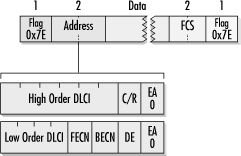The Frame Relay Link Layer
Frame relay is a set of link layer functions. Higher-layer protocols chop up user data, and the resulting bite-size pieces are wrapped in frame relay envelopes to be passed to the network for delivery. The link layer protocol associated with frame relay is the Link Access Procedure for Frame Mode Bearer Services—Core Functions, known more simply as the LAPF Core.[20] LAPF, which is specified in Q.922, is a simpler version of ISDN’s LAPD. The basic frame relay frame is shown in Figure 10-3.

Figure 10-3. The basic frame relay frame
Like the HDLC frame, the frame relay frame opens and closes with a flag. Several header formats may be used, depending on the length of the DLCI. Figure 10-3 shows the most common header format, a 2-byte format that uses 10 bits for the DLCI.[21] At the end of each header byte, the extended address (EA) bit appears. When it is zero, another header byte follows; a one signifies the end of the header. LAPF does not use the command/response (C/R) bit, though higher-layer protocols that require application-specific logic do use this bit.
Frame relay does not include any explicit internode congestion control functions, but it does allow the network to react to congestion in two ways. Traffic in excess of a subscriber’s CIR is marked as discard eligible by setting the discard eligible (DE) bit to one. Frames with ...
Get T1: A Survival Guide now with the O’Reilly learning platform.
O’Reilly members experience books, live events, courses curated by job role, and more from O’Reilly and nearly 200 top publishers.

